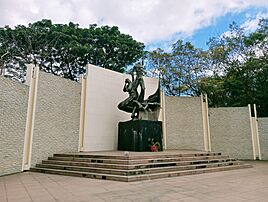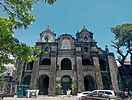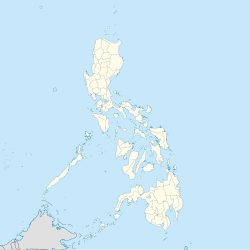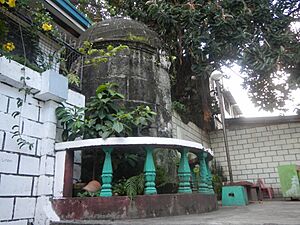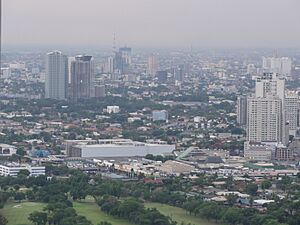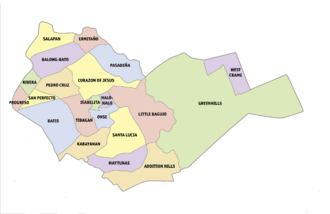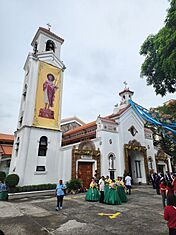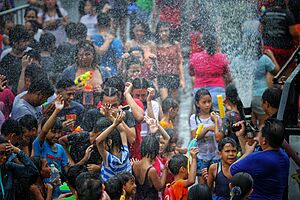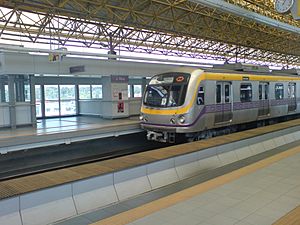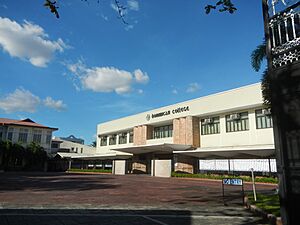San Juan, Metro Manila facts for kids
Quick facts for kids
San Juan
San Juan del Monte
|
|||
|---|---|---|---|
|
Highly urbanized city
|
|||
|
Pinaglabanan Shrine
Greenhills
Santuario del Santo Cristo
City Hall of San Juan
Diwa ng 1896 Monument
Museo ng Katipunan
Hall of Justice
|
|||
|
|||
| Nickname(s):
Dakilang Lungsód ng San Juan (Great City of San Juan)
|
|||
| Motto(s):
Diwa ng 1896 ("Spirit of 1896")
Makabagong San Juan (Modern San Juan) |
|||
| Anthem: San Juan, Sagisag ng Kalayaan (English: San Juan, Symbol of Freedom) | |||
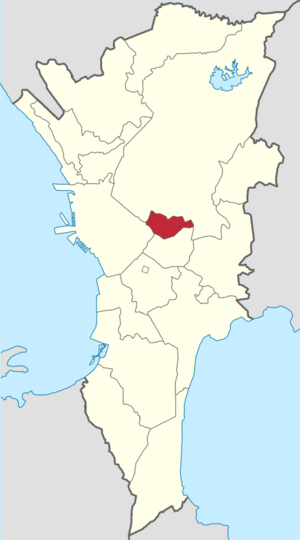
Map of Metro Manila with San Juan highlighted
|
|||
|
OpenStreetMap
|
|||
| Country | Philippines | ||
| Region | National Capital Region | ||
| Province | none | ||
| District | [[{{#property:P7938}} | — Lua error in Module:Wd at line 1804: attempt to index field 'wikibase' (a nil value).]] | ||
| Founded | 1623 | ||
| Annexation to San Felipe Neri | October 12, 1903 | ||
| Chartered | March 27, 1907 | ||
| Cityhood and HUC | June 17, 2007 | ||
| Named for | St. John the Baptist | ||
| Barangays | 21 (see Barangays) | ||
| Government
|
|||
| • Type | Sangguniang Panlungsod | ||
| Area | |||
| • Total | 5.87 km2 (2.27 sq mi) | ||
| Area rank | 145th out of 145 | ||
| Elevation | 24 m (79 ft) | ||
| Highest elevation | 136 m (446 ft) | ||
| Lowest elevation | 0 m (0 ft) | ||
| Population
(2020 census)
|
|||
| • Total | 126,347 | ||
| • Density | 21,524/km2 (55,750/sq mi) | ||
| • Households | 31,519 | ||
| Demonym(s) | San Juaneño (Male) San Juaneña (Female) |
||
| Economy | |||
| • Income class | 1st city income class | ||
| • Poverty incidence |
|
||
| • Revenue | ₱ 2,719 million (2022) | ||
| • Assets | ₱ 7,364 million (2022) | ||
| • Expenditure | ₱ 2,329 million (2022) | ||
| • Liabilities | ₱ 2,226 million (2022) | ||
| Service provider | |||
| • Electricity | Manila Electric Company (Meralco) | ||
| Time zone | UTC+8 (PST) | ||
| PSGC |
[https://psa.gov.ph/classification/psgc/?q=psgc/barangays/{{#pro000®code={{&provcode=
|
||
| IDD : area code | +63 (0)02 | ||
| Native languages | Tagalog | ||
| Catholic diocese | Archdiocese of Manila | ||
| Patron saint | John the Baptist | ||
| Website | www |
||
San Juan, officially known as the City of San Juan (in Filipino, Lungsod ng San Juan), is a busy city in the National Capital Region of the Philippines. In 2020, about 126,347 people lived there. It is located near the center of Metro Manila. San Juan is also the smallest city in the Philippines when it comes to land area.
This city is famous for its history. It was the place of the first battle of the Katipunan. This group led the 1896 Philippine Revolution against the Spanish Empire. Today, you can visit important places like the Pinaglabanan Shrine and old heritage homes. San Juan is also a major shopping area. It has places like Greenhills and Santolan Town Plaza. Here you can find many different kinds of shops, from fancy boutiques to bargain stores.
Contents
What's in a Name?
The name "San Juan" is a shorter version of its old name, "San Juan del Monte." This means "Saint John of the Mountain." Like many places in the Philippines, the name combines a patron saint (Saint John the Baptist) with a description of the area. In this case, it refers to the city's hilly land and higher elevation compared to nearby places.
The city's official nickname is "Dakilang Lungsód ng San Juan," which means "Great City of San Juan."
A Look Back: San Juan's History
Early Times
Long ago, before the Spanish arrived, the area of San Juan was part of the Kingdom of Namayan. The last known rulers of this kingdom were King Lakan Tagkan and his queen, Bouan.
Spanish Rule
In the late 1500s, the Spanish took over the islands. The Kingdom of Namayan became the parish of Santa Ana de Sapa. This is now Santa Ana, Manila. The area of San Juan was called the small town of San Juan del Monte in 1590.
In 1602, the Dominican Order built a special house for their aging or sick friars. They also built a convent and a stone church called the Santuario del Santo Cristo. This church was dedicated to the Holy Cross. This church still stands today.
In 1771, the Spanish government built a strong gunpowder magazine called the Almacén de Pólvora (or El Polvorín) in San Juan del Monte. It was located by the Salapang River (now Salapán Creek).
Becoming a Municipality
In 1783, San Juan del Monte became its own municipality. It separated from the Santa Ana parish. This gave it its own local government. The old town center moved to Camino de Mariquina. A new town hall and plaza were built there.
In 1892, a new church, the San Juan Bautista Church (now Pinaglabanan Church), was built for the municipality.
The Philippine Revolution Begins
In August 1896, the Philippine Revolution against Spain started. The Katipunan revolutionaries, led by Andrés Bonifacio, attacked the El Polvorín (gunpowder magazine) in San Juan del Monte. This happened on August 30, 1896. The Spanish soldiers defended the area. The Katipuneros faced many challenges and had to retreat. This battle was very important. It encouraged Filipinos in other places to fight against the Spanish government.
American Period and Commonwealth Era
After the Philippine Revolution, the Philippines was given to the United States. On February 4, 1899, the first shots of the Philippine–American War were fired in San Juan. An American soldier, Private William W. Grayson, fired at Filipino soldiers. This event marked the start of the war.
Many people left San Juan during the war. After the war, families from nearby towns moved in. In 1901, San Juan became part of the new province of Rizal. In 1903, it was combined with Mandaluyong. But in 1907, San Juan del Monte became an independent municipality again.
Around 1916, the local government bought land for the town market. Later, in 1919, businessmen bought large areas of land. They developed new neighborhoods called San Juan Heights. Around this time, the municipality's name became shorter, just San Juan.
Between 1939 and 1941, some parts of San Juan, like Cubao and Diliman, became part of the new Quezon City.
Japanese Occupation
During World War II, in 1942, San Juan was temporarily merged with Manila and Quezon City to form the City of Greater Manila. It became a separate municipality of Rizal again in 1945.
After Philippine Independence
Becoming Part of Metro Manila
In 1975, San Juan became part of the new National Capital Region. It was no longer part of Rizal Province.
People Power Revolution
Club Filipino, a famous club in San Juan, played a key role in Philippine history. On February 25, 1986, Corazon Aquino was sworn in as president there. This happened on the last day of the 1986 People Power Revolution.
Becoming a City
On June 17, 2007, the people of San Juan voted to make their municipality a highly urbanized city. This was made possible by Republic Act No. 9388.
City of Presidents
San Juan is sometimes called the "City of Philippine Presidents." This is because five presidents have lived there. These include Diosdado Macapagal and his daughter Gloria Macapagal Arroyo, Ferdinand Marcos and his son Bongbong Marcos, and Joseph Estrada. Joseph Estrada also served as Mayor of San Juan.
San Juan's Location and Size
San Juan is the smallest city in the Philippines. It covers an area of about 5.95 square kilometers.
San Juan is surrounded by other cities:
- Quezon City to the north and east
- Mandaluyong to the south
- The City of Manila to the west
The city's territory used to be much larger. It included parts of what are now Quezon City and Mandaluyong.
Weather in San Juan
San Juan has a tropical climate. This means it is generally warm all year round. It has a dry season and a wet season. The hottest months are usually April and May. The rainy season typically runs from June to November.
Barangays: San Juan's Neighborhoods
San Juan is divided into 21 smaller areas called barangays. These are grouped into two city council districts. Each barangay has its own local celebrations, often called fiestas.
- Addition Hills
- Balong–Bato
- Batis
- Corazón de Jesús (Poblacion)
- Ermitaño
- Greenhills
- Isabelita
- Kabayanan
- Little Baguio
- Maytunas
- Onse
- Pasadeña
- Pedro Cruz
- Progreso
- Rivera
- Saint Joseph (Halo-Halo)
- Salapán
- San Perfecto
- Santa Lucia
- Tibagan
- West Crame
People of San Juan
Places of Worship
San Juan has many important churches and places of worship. The Archdiocesan Shrine of Saint John the Baptist is where the city's patron saint, John the Baptist, is honored. The Santuario del Santo Cristo is the oldest church still standing in the city. Mary the Queen Parish in West Greenhills serves the local Filipino-Chinese community.
The Iglesia ni Cristo once had its main office in San Juan. The chapel there was designed by National Artist for Architecture Juan Nakpil. San Juan also has several Evangelical churches and two Islamic mosques. In 2024, St. John the Baptist was officially declared the patron saint of San Juan City.
San Juan's Economy
San Juan is mostly a residential city, meaning many people live there. But it also has many businesses and factories.
The Greenhills shopping district is the main center for trade and business in San Juan. This large shopping area includes malls like Virra Mall, Shoppesville, Greenhills Theatre Mall, Promenade Mall, and Unimart.
In 2022, San Juan had a high percentage of its population working, showing a strong local economy.
Culture and Festivals
Wattah Wattah Festival
Since 2003, San Juan celebrates the feast of its patron saint, St. John the Baptist, every June 24. This celebration is called the Wattah Wattah Festival. It features dancing, parades, and a fun tradition called basaan, where people splash water on each other in the streets. The main activities happen along N. Domingo Street and Pinaglabanan Street.
To keep everyone safe, the city has rules for the festival. People are not allowed to use dirty water, ice, water in glass bottles, or anything that could cause injury. Physical violence and splashing water on people in public transport are also not allowed.
During the COVID-19 pandemic in 2020 and 2021, the festival was smaller. It only had a parade of the saint's image with safety rules. In 2022, with fewer cases, the traditional basaan returned. It was joined by street dancing, a concert, and fireworks.
Sports in San Juan
San Juan has a rich history with sports. The Filoil EcoOil Centre has hosted many sports events. These include games for the Philippine Basketball Association, Maharlika Pilipinas Basketball League, and Premier Volleyball League.
The city also has its own basketball team, the San Juan Knights. They have won three league championships.
Getting Around San Juan
You can travel around San Juan using jeepneys and buses. Jeepney routes run along Aurora Boulevard. The city has one train station, J. Ruiz station, which is part of the LRT Line 2. The C-3 (Araneta Avenue) also goes through San Juan. Other important roads include Nicolas Domingo (N. Domingo) Street and Pinaglabanan Street.
Learning in San Juan
The Schools Divisions Office (SDO) of San Juan manages 9 public elementary schools, 2 public high schools, and a science high school. There are also 24 private schools in the city.
For higher education, the state-run Polytechnic University of the Philippines has a campus in San Juan. Dominican College, established in 1924, is one of the oldest private schools.
The city also has two culinary schools: the Center for Asian Culinary Studies and the Instituto Culinario.
Famous People from San Juan
Many well-known people have lived in San Juan. Here are some of them:
- Alfred Vargas, actor and politician
- Bongbong Marcos, current President of the Philippines
- Chris Tiu, TV host and basketball player
- Don Allado, basketball player and city councilor
- Edu Manzano, actor and former politician
- Eraño Manalo, former leader of Iglesia ni Cristo
- Ferdinand Marcos, former President of the Philippines
- Francis Zamora, current San Juan Mayor
- Franklin Drilon, former senator
- Gabby Concepcion, actor and singer
- Gloria Macapagal Arroyo, former President of the Philippines
- Grace Poe, senator
- Imee Marcos, senator
- Imelda Marcos, former First Lady
- Jake Ejercito, actor
- James Yap, basketball player and city councilor
- Janella Salvador, actress and singer
- Jinggoy Estrada, senator and actor
- Joseph Estrada, former President of the Philippines and Mayor of San Juan
- JV Ejercito, senator and former Mayor of San Juan
- Luis Manzano, actor and TV host
- Max Soliven, famous journalist
- Paul Artadi, basketball player and city councilor
- Philip Cezar, basketball player and former Vice Mayor
- Ronaldo Zamora, former congressman
- Teofisto Guingona Jr., former Vice President of the Philippines
- Yasmien Kurdi, actress
- Diego Loyzaga, actor
- Bayani Fernando, former politician
- E.R. Ejercito, actor
- Mikha Lim, member of Bini
- Reynolds Michael T. Tan, congressman
Sister Cities
San Juan has special connections with other cities, both in the Philippines and around the world.
Local Sister Cities
International Sister Cities
 Coquitlam, British Columbia, Canada
Coquitlam, British Columbia, Canada San Juan, Puerto Rico
San Juan, Puerto Rico Maui, Hawaii, United States
Maui, Hawaii, United States Santa Barbara, California, United States
Santa Barbara, California, United States
Images for kids
See also
 In Spanish: San Juan (Gran Manila) para niños
In Spanish: San Juan (Gran Manila) para niños


